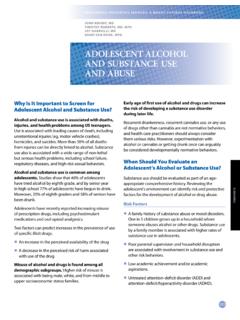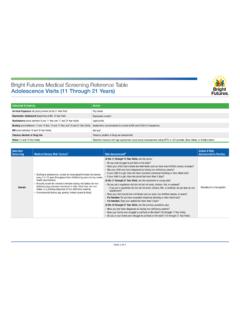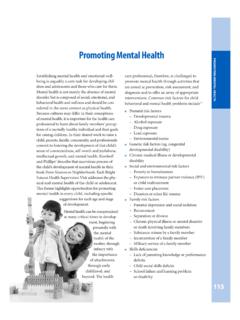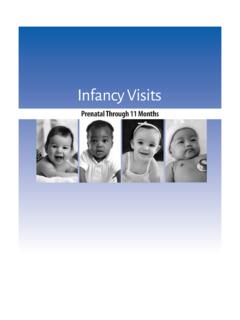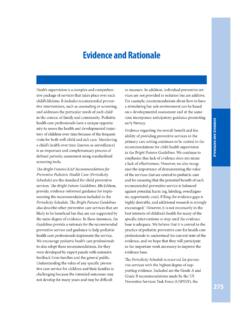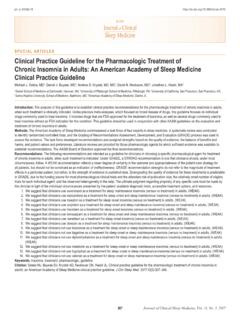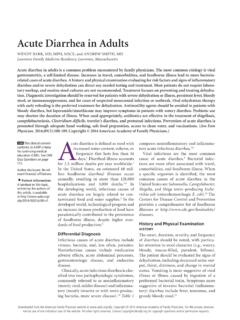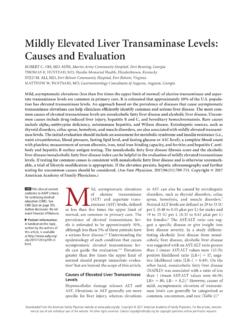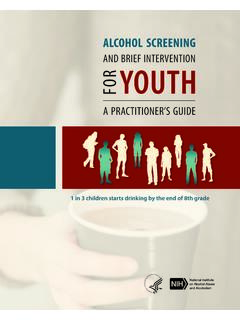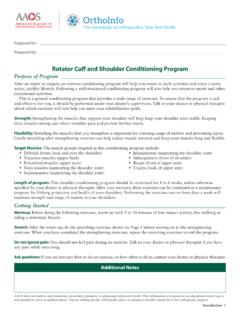Transcription of Promoting Oral Health - American Academy of Pediatrics
1 205 Promoting ORAL HEALTHP romoting Oral HealthOral Health is critically important to the overall Health and well-being of infants, children, and adolescents. It covers a range of Health promo-tion and disease prevention concerns, including dental caries; periodontal (gums) Health ; proper development and alignment of facial bones, jaws, and teeth; other oral diseases and condi-tions; and trauma or injury to the mouth and teeth. Oral Health is an important issue requiring continued Health supervision from the Health care professional. Childhood caries is a preventable and transmis-sible infectious disease caused by bacteria (eg, Streptococcus mutans or Streptococcus sobrinus) that form plaque on the surface of teeth.
2 The bac-teria interact with sugar in foods and beverages, turning them into acids that dissolve tooth enamel, causing caries. Caries is one of the most common chronic diseases in children 5 times more common than Left untreated, pain and infection caused by dental caries can lead to prob-lems in eating, speaking, and Twe nt y -three percent of children aged 2 to 5 years and 56% of children aged 6 to 8 have caries, and many school hours are lost each year because of dental problems related to Dental caries is a complex disease with individual-, family-, and community-level Several population groups are particularly vulnerable to caries. For example, children and youth with special Health care needs are at increased risk.
3 National surveys also have demonstrated that chil-dren in low- and moderate-income households are more likely to have caries and more decayed teeth than are children from more affluent households. Even within income levels, children of color are more likely to have caries than are white Thus, sociodemographic status should be viewed as an initial indicator of 4TH 2051/20/17 2:46 PMBright Futures Guidelines for Health Supervision of Infants, Children, and Adolescents206 Promoting ORAL HEALTHH ealth care professionals can teach children, adolescents, and their families about oral hygiene, healthy diet and feeding practices, optimal expo-sure to fluoride, and timely referral to a dentist (see Box 1 for useful resources).
4 Health care pro-fessionals also often provide the initial response for oral trauma. They should keep in mind that the differential diagnosis for oral trauma includes intentional The Importance of a Dental Home The dental home is the ongoing relationship between the dentist and the patient, includes all aspects of oral Health , and is delivered in a com-prehensive, continuously accessible, coordinated, and family-centered way (Box 2).8 Three dental organizations (the American Dental Association, the Academy of General Dentistry, Box 2 Responsibilities of the Dental Home9 According to the AAPD, the dental home should provide Comprehensive oral Health care, including acute care and preventive services, in accordance with AAPD periodicity schedules.)
5 Comprehensive assessment for oral diseases and conditions. An individualized preventive dental Health program based on a caries risk assessment and a periodontal disease risk assessment. Anticipatory guidance about growth and development issues (ie, teething, thumb- or finger-sucking behaviors, or pacifier habits). A plan for responding to acute dental trauma. Information about proper care of the child s teeth and gingivae. This would include prevention, diagnosis, and treatment of disease of the supporting and surrounding tissues and the maintenance of Health , function, and esthetics of those structures and tissues. Dietary counseling. Referrals to dental specialists when care cannot directly be provided within the dental home.
6 Education regarding future referral to a dentist knowledgeable and comfortable with adult oral Health issues for continuing oral Health care. Referral at an age determined by patient, parent, and pediatric : AAPD, American Academy of Pediatric with permission from American Academy of Pediatric Dentistry Council on Clinical Affairs. Policy on the dental home. Pediatr Dent. 2015;37(6)(Reference Manual):24-25. Box 1 Oral Health ResourcesBright Futures in Practice: Oral Health Pocket Guide (2016) provides a structured and comprehensive approach to oral Health anticipatory guidance for the Health care The Health Resources and Services Administration National Maternal and Child Oral Health Resource Center ( ) also provides many valuable tools and resources for Health care Additional information is available at the AAP Web site ( ).
7 Abbreviation: AAP, American Academy of 4TH 2061/20/17 2:46 PMBright Futures Guidelines for Health Supervision of Infants, Children, and Adolescents207 Promoting ORAL HEALTHand the American Academy of Pediatric Dentistry [AAPD]) are united in encouraging parents to establish a dental home for their child no later than 12 months of As children and adoles-cents mature into adulthood, a dental home also can ensure that they receive oral Health education and counseling, preventive and early intervention measures, and treatment, including treatment for periodontal care, orthodontic services, trauma, and other to establish a dental home offer an oppor-tunity for partnerships and foster a connection with the community.
8 A partnership among Health care professionals in primary care, dental Health , public Health , early care and education (including child care and home visiting), and school settings can help ensure access to a dental home for each child during the early childhood, middle child-hood, and adolescent years. Fluoride Fluoride plays a key role in preventing and con-trolling caries. Fluoride helps reduce the loss of minerals from tooth enamel (demineralization) and promotes the replacement of minerals (remineralization) in dental enamel that has been damaged by acids produced by bacteria in plaque. Regular and frequent exposure to small amounts of fluoride is the best way to protect the teeth against caries.
9 This exposure can be readily accomplished through drinking water that has been optimally fluoridated10 and brushing with fluoride toothpaste twice Fluoride supplementation typically is not needed in the first 6 months of life. Children who do not drink fluoridated water should begin taking flu-oride supplements (ie, drops or chewable tablets) at 6 months of Parents can purchase bottled water that contains fluoride, as an alternative to fluoride supplements. Evidence reviewed by the US Preventive Services Task Force (USPSTF) found oral fluoride supplementation effective at reducing caries ,14 Additional types of fluoride may be used as a primary preventive measure and, generally, are recommended for infants, children, and adoles-cents who are deemed to be at high risk of caries.
10 Research has shown that the primary caries pre-vention effects of fluoride result from its topical contact with enamel and through its antibacterial The USPSTF also found new evidence to support the effectiveness of fluoride varnish in infants and children, starting at first primary tooth eruption through age ,14 Even if indicated, additional or combination of flu-oride intake should be used judiciously in children to minimize the risk of fluorosis from the overex-posure to fluoride. Fluoride varnish is not a risk factor for fluorosis. Fluorosis can come from swal-lowing too much toothpaste that contains fluoride, drinking water with higher than recommended fluoride levels, and taking fluoride supplements when other sources of fluoride are To prevent fluorosis, if noncommunity water sources, such as wells and other natural sources, are the primary water sources, they must be tested before parents are advised to supplement with all children and adolescents, optimal fluoride levels in drinking water combined with fluoride- containing preparations, such as toothpastes, gels, varnishes, and rinses, have significantly reduced dental decay, but caries risk remains high during.



